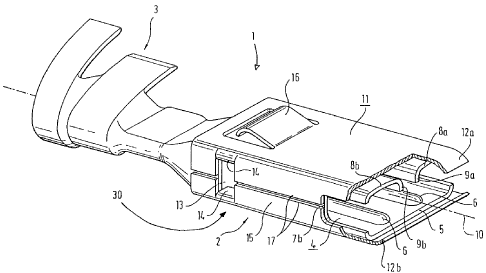Some of the information on this Web page has been provided by external sources. The Government of Canada is not responsible for the accuracy, reliability or currency of the information supplied by external sources. Users wishing to rely upon this information should consult directly with the source of the information. Content provided by external sources is not subject to official languages, privacy and accessibility requirements.
Any discrepancies in the text and image of the Claims and Abstract are due to differing posting times. Text of the Claims and Abstract are posted:
| (12) Patent: | (11) CA 2257988 |
|---|---|
| (54) English Title: | CONNECTOR BUSHING |
| (54) French Title: | DOUILLE CONNECTRICE |
| Status: | Deemed expired |
| (51) International Patent Classification (IPC): |
|
|---|---|
| (72) Inventors : |
|
| (73) Owners : |
|
| (71) Applicants : |
|
| (74) Agent: | BKP GP |
| (74) Associate agent: | |
| (45) Issued: | 2003-09-02 |
| (86) PCT Filing Date: | 1997-06-16 |
| (87) Open to Public Inspection: | 1997-12-24 |
| Examination requested: | 2000-05-03 |
| Availability of licence: | N/A |
| (25) Language of filing: | English |
| Patent Cooperation Treaty (PCT): | Yes |
|---|---|
| (86) PCT Filing Number: | PCT/EP1997/003117 |
| (87) International Publication Number: | WO1997/049145 |
| (85) National Entry: | 1998-12-11 |
| (30) Application Priority Data: | |||||||||
|---|---|---|---|---|---|---|---|---|---|
|
A plug connector sleeve (1) with a plug region (2) and a conductor connection
region (3), in which the plug region takes the form of a sleeve (4) with a
base (5), two side walls (7a, 7b) which are bent up from the base (5) and has
two cover halves (8a, 8b) running from the side walls and have free ends (9a,
9b) which are bent around towards the inside of the sleeve. The plug connector
sleeve (1) has a central base region (30) which follows the plug region (2),
is box-shaped with a base section, in the extension of the base of the plug
region with side walls in the extension of the side walls of the plug region
and with a cover section formed by third and fourth cover halves (18, 19)
which are formed by bending the side walls of the central base region.
L'invention concerne une douille de connecteur à fiches (1) comportant une zone d'enfichage (2) et une zone de connexion de conducteurs (3), la zone d'enfichage se présentant sous forme de douille (4) avec un fond (5), deux parois latérales (7a, 7b) cintrées vers le haut depuis le fond (5) et comportant une première et une seconde moitié de couverture (8a, 8b) qui partent des parois latérales et présentent des extrémités libres (9a, 9b) recourbées vers l'intérieur de la douille. La douille de connecteur à fiches (1) comporte une zone de base (30) médiane qui suit la zone d'enfichage (2), se présente sous forme de boîte, avec une partie de base, dans le prolongement du fond de la zone d'enfichage et avec une partie de couverture formée par une troisième et une quatrième moitié de couverture (18, 19), obtenues par cintrage des parois latérales de la zone de base médiane.
Note: Claims are shown in the official language in which they were submitted.
Note: Descriptions are shown in the official language in which they were submitted.

For a clearer understanding of the status of the application/patent presented on this page, the site Disclaimer , as well as the definitions for Patent , Administrative Status , Maintenance Fee and Payment History should be consulted.
| Title | Date |
|---|---|
| Forecasted Issue Date | 2003-09-02 |
| (86) PCT Filing Date | 1997-06-16 |
| (87) PCT Publication Date | 1997-12-24 |
| (85) National Entry | 1998-12-11 |
| Examination Requested | 2000-05-03 |
| (45) Issued | 2003-09-02 |
| Deemed Expired | 2007-06-18 |
There is no abandonment history.
| Fee Type | Anniversary Year | Due Date | Amount Paid | Paid Date |
|---|---|---|---|---|
| Application Fee | $300.00 | 1998-12-11 | ||
| Registration of a document - section 124 | $100.00 | 1999-02-22 | ||
| Maintenance Fee - Application - New Act | 2 | 1999-06-16 | $100.00 | 1999-04-26 |
| Request for Examination | $400.00 | 2000-05-03 | ||
| Maintenance Fee - Application - New Act | 3 | 2000-06-16 | $100.00 | 2000-05-03 |
| Maintenance Fee - Application - New Act | 4 | 2001-06-18 | $100.00 | 2001-05-18 |
| Maintenance Fee - Application - New Act | 5 | 2002-06-17 | $150.00 | 2002-06-05 |
| Maintenance Fee - Application - New Act | 6 | 2003-06-16 | $150.00 | 2003-05-13 |
| Registration of a document - section 124 | $100.00 | 2003-06-02 | ||
| Registration of a document - section 124 | $100.00 | 2003-06-02 | ||
| Section 8 Correction | $200.00 | 2003-06-02 | ||
| Final Fee | $300.00 | 2003-06-09 | ||
| Maintenance Fee - Patent - New Act | 7 | 2004-06-16 | $200.00 | 2004-06-09 |
| Maintenance Fee - Patent - New Act | 8 | 2005-06-16 | $200.00 | 2005-05-27 |
Note: Records showing the ownership history in alphabetical order.
| Current Owners on Record |
|---|
| FCI |
| Past Owners on Record |
|---|
| F.C.I. - FRAMATOME CONNECTORS INTERNATIONAL |
| LEHNER, ANTON |
| MOSER, HANS |
| NOTTROTT, RUDOLF |